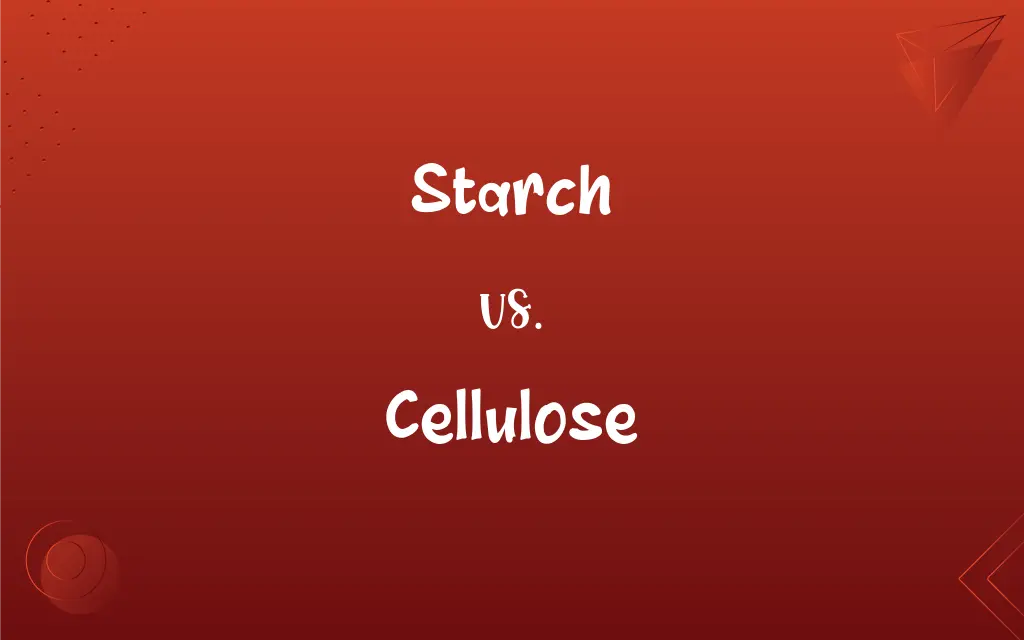Starch vs. Cellulose: What's the Difference?
Edited by Janet White || By Harlon Moss || Updated on October 9, 2023
Starch is a digestible polysaccharide storage form of glucose in plants, while cellulose is an indigestible structural component of plant cell walls.

Key Differences
Starch and cellulose are both carbohydrates found in plants, but they serve very different roles. While starch is used primarily as an energy storage molecule, cellulose provides structural support to plant cell walls.
At the molecular level, both starch and cellulose consist of glucose units. However, in starch, these glucose units are connected by alpha linkages, allowing humans to digest it. In contrast, cellulose's glucose units are connected by beta linkages, making it indigestible to humans.
One notable difference between starch and cellulose is their appearance under the microscope. Starch granules often appear oval or spherical, while cellulose has a more fibrous appearance.
When considering their uses, starch finds a role in human diets and various industries like textiles and paper due to its thickening properties. Cellulose, on the other hand, is used in paper production, textiles, and as a thickener in some food products.
Lastly, from a nutritional standpoint, while starch provides an energy source for humans, cellulose is considered dietary fiber, aiding in digestion but not contributing calories.
ADVERTISEMENT
Comparison Chart
Primary Role in Plants
Energy storage molecule
Structural component of plant cell walls
Molecular Linkages
Alpha linkages between glucose units
Beta linkages between glucose units
Digestibility
Digestible by humans
Indigestible by humans
Appearance
Oval or spherical granules under the microscope
Fibrous appearance
Main Uses
Human diet, textiles, paper industry (thickening properties)
Paper production, textiles, thickener in some food products
ADVERTISEMENT
Starch and Cellulose Definitions
Starch
Digestible polysaccharide consisting of glucose units.
Humans derive energy from the starch they consume.
Cellulose
Acts as dietary fiber in the human diet, aiding digestion.
Eating vegetables provides cellulose, which helps in digestion.
Starch
Provides calories when consumed by humans.
The starch in bread provides energy to our bodies.
Cellulose
A carbohydrate forming the structural component of plant cell walls.
Cellulose gives rigidity to plant stems and leaves.
Starch
Utilized in various industries due to its thickening properties.
Starch is a key ingredient in gravy to give it the right consistency.
Cellulose
Exhibits a fibrous appearance under the microscope.
The cellulose fibers were clearly visible under high magnification.
Starch
A carbohydrate used for energy storage in plants.
Potatoes are a rich source of starch.
Cellulose
Used in paper production, textiles, and as a food thickener.
High-quality paper is often made from pure cellulose.
Starch
Often appears as oval or spherical granules under a microscope.
Under the microscope, the starch in the sample was evident.
Cellulose
An indigestible polysaccharide with beta linkages between glucose units.
Humans lack the enzyme to break down cellulose, making it fiber in our diet.
FAQs
Are starch and cellulose found in all plants?
Most plants contain both starch (in seeds and storage organs) and cellulose (in cell walls).
What are starch and cellulose primarily made of?
Both starch and cellulose are polysaccharides made of glucose units.
Can animals digest cellulose?
Some animals, like cows, have symbiotic bacteria that help them digest cellulose.
How can one differentiate starch from cellulose under a microscope?
Starch often appears as oval or spherical granules, while cellulose has a fibrous appearance.
How do starch and cellulose benefit the human diet?
Starch provides energy, while cellulose acts as dietary fiber, aiding digestion.
What's the significance of the alpha and beta linkages in starch and cellulose?
The type of linkage (alpha in starch, beta in cellulose) determines the digestibility and structural characteristics of these polysaccharides.
Can starch be converted into sugars?
Yes, enzymes like amylase can break down starch into simpler sugars, which is what occurs during digestion.
Are there foods specifically marketed for their starch content?
Yes, many foods like cornstarch and tapioca are marketed primarily for their starch content, especially for culinary uses.
Are there synthetic alternatives to cellulose in the textile industry?
Yes, there are synthetic fibers, but rayon, a semi-synthetic fiber, is directly derived from cellulose.
Why can humans digest starch but not cellulose?
Humans can digest starch due to its alpha linkages, while cellulose has beta linkages which humans can't break down.
Why can't humans derive energy from cellulose like they can from starch?
Humans lack the necessary enzyme to break down the beta linkages in cellulose, rendering it indigestible.
Why are ruminants like cows and sheep able to digest cellulose?
Ruminants possess special stomach compartments containing microbes that can break down cellulose into digestible nutrients.
Why is cellulose important to the paper and textile industries?
Cellulose provides the primary raw material in papermaking and is also used to produce textiles like rayon.
Do both starch and cellulose dissolve in water?
While some starches can dissolve in warm water forming a paste, cellulose does not dissolve in water.
What's the role of cellulose in a plant's growth and stability?
Cellulose provides structural integrity to plant cells, allowing them to maintain their shape and resist external pressures.
Do processed foods contain cellulose?
Some processed foods use cellulose as a thickener, stabilizer, or dietary fiber supplement.
In what forms is starch typically found in foods?
Starch is often found in foods like potatoes, rice, corn, and wheat, and it can be in the form of grains, tubers, and legumes.
How do plants benefit from storing starch?
Starch acts as an energy reserve for plants, which they can utilize during periods when photosynthesis is not occurring.
Is cellulose the most abundant organic polymer on Earth?
Yes, cellulose is the most abundant organic polymer, given its presence in the cell walls of billions of plants worldwide.
Are there different types of starch?
Yes, the two main types of starch are amylose and amylopectin, with different structures and properties.
About Author
Written by
Harlon MossHarlon is a seasoned quality moderator and accomplished content writer for Difference Wiki. An alumnus of the prestigious University of California, he earned his degree in Computer Science. Leveraging his academic background, Harlon brings a meticulous and informed perspective to his work, ensuring content accuracy and excellence.
Edited by
Janet WhiteJanet White has been an esteemed writer and blogger for Difference Wiki. Holding a Master's degree in Science and Medical Journalism from the prestigious Boston University, she has consistently demonstrated her expertise and passion for her field. When she's not immersed in her work, Janet relishes her time exercising, delving into a good book, and cherishing moments with friends and family.































































